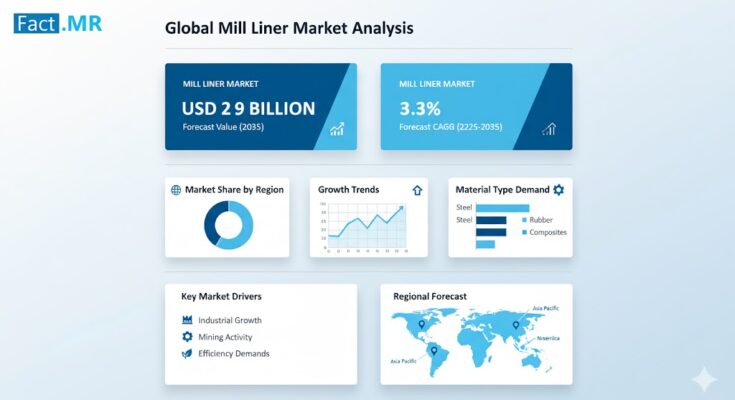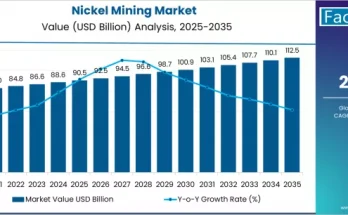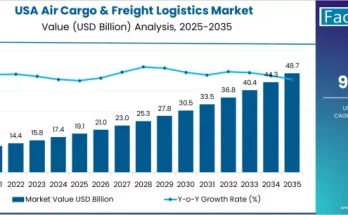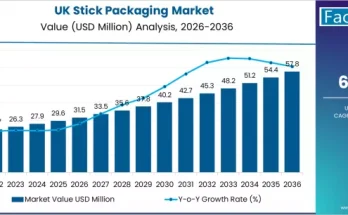The global mill liner market stands at the threshold of a decade-long expansion trajectory that promises to reshape mining equipment technology and mineral processing solutions. According to a recent report by Fact.MR, the market is projected to grow from USD 2.1 billion in 2025 to USD 2.9 billion by 2035, reflecting a CAGR of 3.3% during the forecast period. This growth underscores the accelerating adoption of advanced liner technologies, automation-driven maintenance systems, and optimized grinding solutions across mining, cement, and mineral processing sectors.
Strategic Market Drivers
- Rising Demand for Wear-Resistant and Smart Liner Solutions
The demand for high-performance wear-resistant liners, particularly those made from composite materials, rubber, and high-chrome steel, continues to rise as industries prioritize operational efficiency and equipment longevity. Modern smart liners equipped with embedded sensors are enabling real-time wear monitoring and predictive maintenance, minimizing downtime and improving plant productivity. - Growth in Mineral Processing and Cement Production
As global mining output and cement production rebound, the need for reliable grinding and milling solutions has surged. The growing application of mill liners in ball mills, SAG mills, and rod mills is strengthening their role as critical components in ore beneficiation and material size reduction processes. - Sustainability and Circular Economy Integration
Environmental stewardship is emerging as a decisive factor in the mill liner industry. Manufacturers are increasingly utilizing recyclable materials, eco-friendly composites, and energy-efficient production processes. This shift toward sustainable operations aligns with global ESG goals, particularly in regions with stringent environmental compliance requirements. - Technological Innovations in Liner Design and Material Science
Advancements in computational simulation, 3D wear analysis, and high-performance alloys are transforming liner design. Tailored geometries and modular configurations are being developed to improve impact resistance and grinding efficiency while reducing replacement frequency. The adoption of AI-enabled condition monitoring and digital twin technologies is further enhancing plant reliability and lifecycle cost management.
Browse Full Report: https://www.factmr.com/report/3855/mill-liner-market
Regional Growth Highlights
North America: Industrial Modernization and Process Optimization
The U.S. and Canada lead the adoption of advanced liner systems supported by robust investments in mining automation and cement modernization. Increasing replacement demand in aging grinding systems and a focus on minimizing unplanned downtime are key drivers.
Europe: Focus on Sustainable and High-Precision Grinding Technologies
Europe’s strong industrial engineering base and commitment to sustainable mining practices are propelling the adoption of optimized liner materials. The integration of sensor-based wear tracking and advanced composites is reinforcing regional market competitiveness.
East Asia: Fastest-Growing Market with Expanding Mining Output
East Asia, led by China, is witnessing substantial growth in mining infrastructure and mineral processing capacity. Expanding demand for efficient ore beneficiation solutions and cost-optimized liner replacement cycles is propelling the market forward.
Latin America and Africa: Resource-Rich Regions Driving Demand Surge
Countries such as Chile, Peru, and South Africa are capitalizing on rising mineral extraction activities. Growing foreign investments in mining projects and capacity expansions in copper and iron ore processing are strengthening liner sales.
Market Segmentation Insights
By Liner Type:
- Metal Liners
- Rubber Liners
- Composite Liners
- Magnetic Liners
By Mill Type:
- Ball Mills
- SAG Mills
- Rod Mills
- Pebble Mills
By End Use:
- Mining
- Cement Production
- Power Plants
- Industrial Mineral Processing
By Region:
- North America
- Europe
- East Asia
- South Asia & Oceania
- Latin America
- Middle East & Africa
Challenges and Market Considerations
Despite a positive outlook, the mill liner market faces challenges such as volatile metal prices, high installation costs, and complex maintenance protocols in remote mining environments. However, continuous R&D in modular liner systems, digital maintenance solutions, and lightweight materials is addressing these issues—enhancing productivity and sustainability across end-use industries.
Competitive Landscape
The mill liner market is moderately consolidated, with key players focusing on technological innovation, material performance enhancement, and global service network expansion. Leading companies are integrating digital platforms for lifecycle management and predictive maintenance, catering to the evolving needs of mining operators.
Key Players in the Mill Liner Market:
- Weir Minerals Australia Ltd.
- Metso Outotec Corporation
- FLSmidth & Co. A/S
- Multotec Group
- Magotteaux International S.A.
- Polycorp Ltd.
- Walter Surface Technologies LLC
- Norstone, Inc.
- Osborn Engineered Products Inc.
- MIPR Corporation
Recent Developments
- March 2024 – Metso Outotec Corporation launched an AI-driven wear tracking system to enhance mill liner lifespan prediction and optimize replacement scheduling.
- October 2023 – FLSmidth & Co. A/S introduced a sustainable composite liner range with improved recyclability and lower carbon footprint.
- June 2023 – Weir Minerals Australia Ltd. expanded its R&D facility in Perth to accelerate innovations in high-chrome and rubber-based liner materials.
Future Outlook: Toward Smart, Sustainable, and Predictive Grinding Systems
The next decade will witness the convergence of smart materials, IoT-enabled monitoring, and sustainable production models in the mill liner industry. As mining and mineral processing sectors embrace automation, predictive analytics, and environmental accountability, mill liner manufacturers are evolving toward intelligent, durable, and eco-efficient solutions.
With strong demand from global mining and cement industries, the mill liner market is poised for steady and resilient growth. Companies that invest in digital innovation, sustainability, and customer-centric service ecosystems will define the next generation of performance-driven, environmentally responsible milling solutions.



